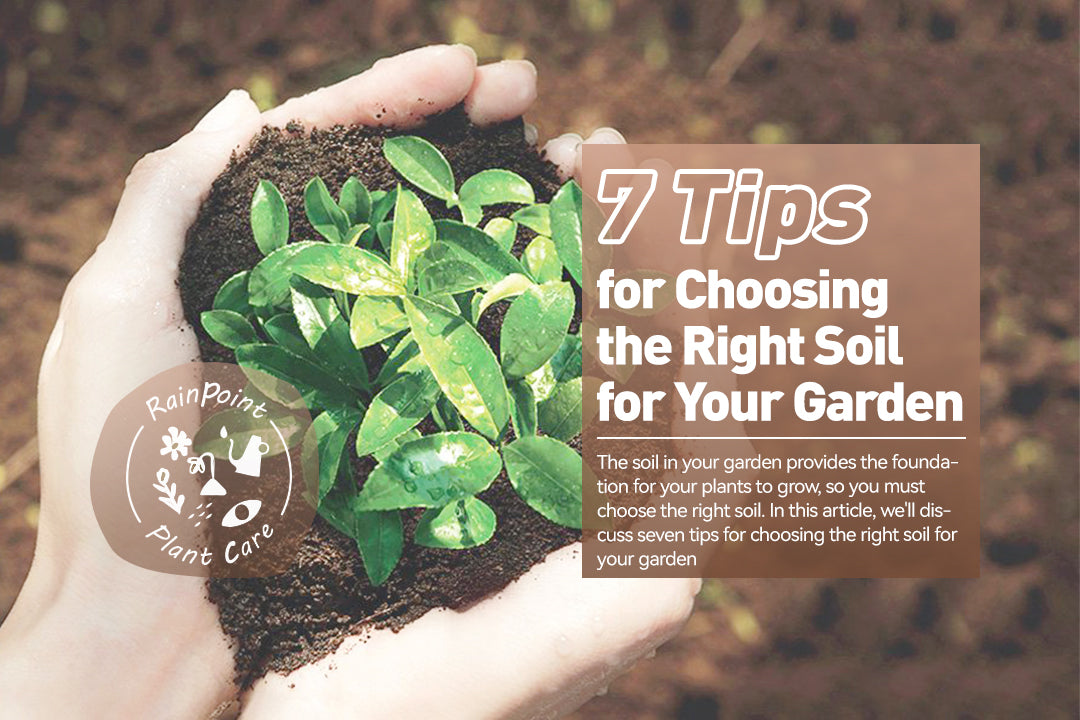Gardening is an enjoyable and rewarding hobby that can provide you with fresh produce and beautiful flowers. To have a thriving garden, it is important to have the right soil. The soil in your garden provides the foundation for your plants to grow, so you must choose the right soil. In this article, we'll discuss seven tips for choosing the right soil for your garden.
Tip 1 : Know your oil type
Before you start planting, it's important to know your soil type. All soils are made up of a mixture of mineral particles, and different textures differ in their density, drainage, and ability to hold nutrients.
Soils can be divided into three main types:
- Clay- contains dense, tiny particles that can store large amounts of water and nutrients. However, it drains slowly and compacts when dry.
- Loamy soils-A mixture of sand, silt, and clay, rich in humus, ideal for most plants.
- Sandy soils-Dominated by sand grains, the soil is more permeable and breathable, but less able to retain water and nutrients.

Knowing your soil type will help you determine which amendments you need to add to create the right soil for your garden.
Tip 2 : Consider the Plants You Want to Grow
Different plants have different soil requirements. For example, some plants prefer well-drained soil, while others prefer moist and nutrient-rich soil. When choosing the right soil for your garden, consider the plants you want to grow and their soil requirements. By considering the plants you want to grow, you can choose the soil that is best suited for their growth and development.

For example:
- Cacti and succulents like well-drained, sandy, or rocky soil.
- Vegetables such as tomatoes, peppers, and cucumbers need well-drained, nutrient-rich soil.
- Hostas and ferns prefer moist and organic-rich soils.
Tip 3: Look for S oil with The Right pH
Different plants have different pH preferences, so you need to know the current pH of your soil before planting to determine if it needs to be adjusted to meet the needs of your plants.
For example:
- Blueberries prefer acidic soils with a pH range of 4.0-5.0.
- Tomatoes prefer slightly acidic to neutral soil with a pH range of 6.0-7.0.
To determine the pH of your soil, you can purchase a soil pH test kit or send a sample to a soil testing lab. If the soil is too acidic, you can add agricultural lime, wood ash, or crushed eggshells to raise the pH. If it is too alkaline, you can lower the pH by adding substances such as sulfur, peat moss, or pine needles. By adjusting the pH of your soil, you can create a soil environment that is best for your plants.

Tip 4: Choose S oil with lots of organic matter
Organic matter can help improve soil structure, enhance soil fertility, and promote healthy plant growth. Choose soil that is dark in color and friable in texture; This soil is usually rich in humus and has a high organic content. You can also add organic matter, such as compost, peat moss, or aged manure, to the soil to improve its organic content and increase its water-holding capacity.

Don't forget to consider the specific requirements of your plants when choosing soil that contains a lot of organic matter.
For example:
- Cacti, lavender, and succulents prefer well-drained soils with low organic matter content.
- Spinach, tomatoes, cucumbers, and other fruits and vegetables need a lot of organic matter to support their growth and development.
Tip 5 : Look for S oil with Good Drainage
Good drainage will prevent root rot and other problems caused by waterlogged soil. To improve the drainage of your soil, you can mix in materials such as sand, perlite, or vermiculite. These materials improve the aeration and drainage of the soil and also prevent soil compaction, and promote healthy root growth.
Tip 6 : Avoid S oil Containing P ests or Diseases
Using soil that contains pests or diseases can be detrimental to the health of your plants. To avoid pests and diseases in your soil, you can buy sterile potting soil or use soil that has been treated to kill any pests or diseases. You can also use a soil disinfectant to kill any pests or diseases in the soil.

Tip 7: Consider the environment
In addition to moisture retention and drainage, you should also consider the climate of your area. If you live in a hot and dry climate, choose soil that is drought-resistant and retains moisture. Conversely, if you live in a cool and humid climate, choose soils that drain well and prevent water logging.
Conclusion
In conclusion, knowing your soil type and the needs of the plants you want to grow is the key to choosing the right soil. Consider all the influencing factors together to make the best decision. With the right soil, your plants will thrive and you will be able to enjoy a beautiful and prosperous life.



1 comment
Recently, my mother developed an interest in gardening, so I made the decision to provide a hand and do a little research on the gardening supplies she might require. It’s a good thing I stumbled across your site because you mentioned how utilizing soil that contains pests can be bad for plants’ health and how buying dirt that has been treated to kill any pests or illnesses might be useful. I appreciate you sharing! I’ll be sure to let her know about this and look into garden supply stores that might be able to assist us in purchasing.
https://www.meltongardensupplies.com.au/sandand-soil-supplies.php